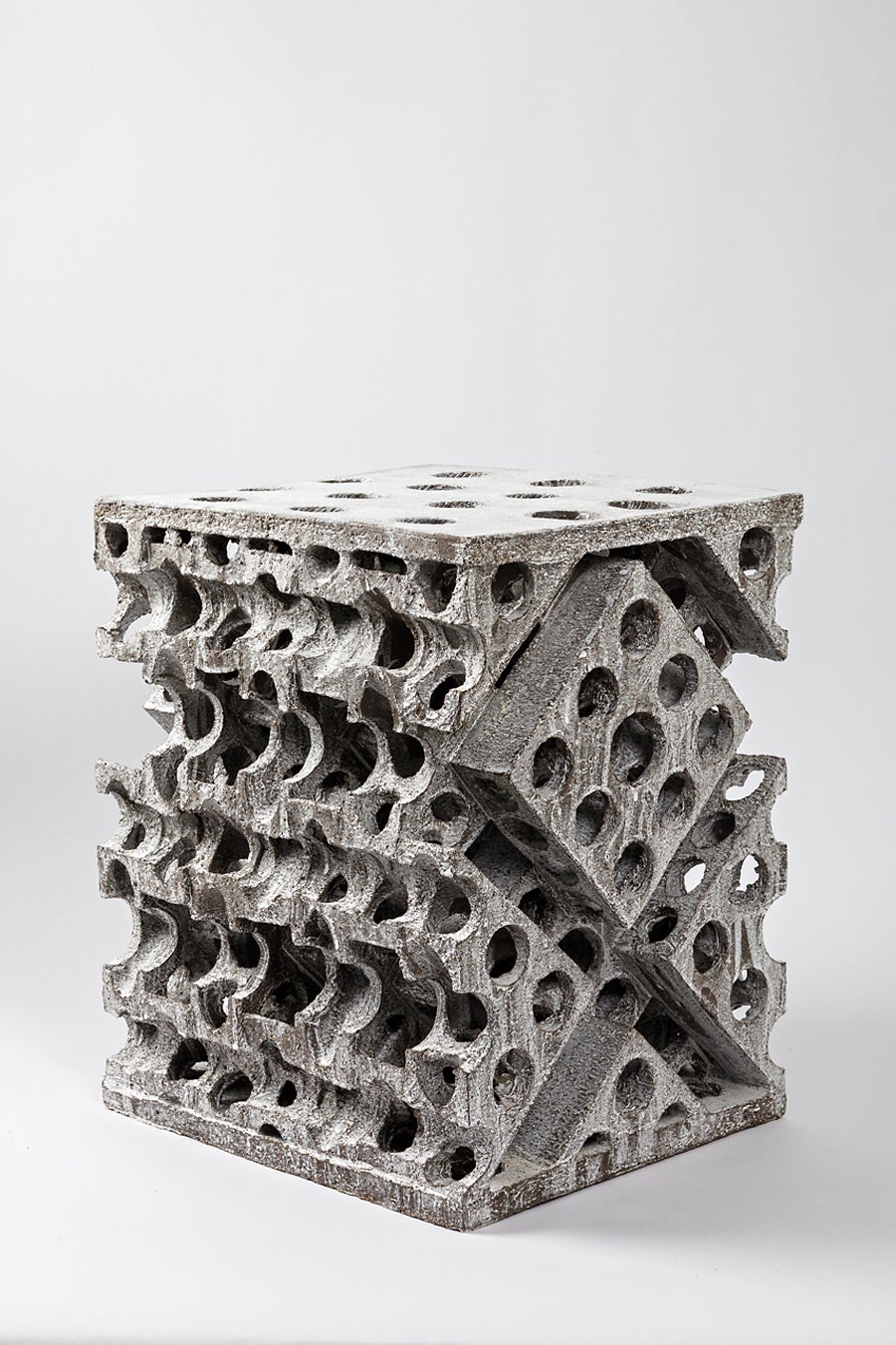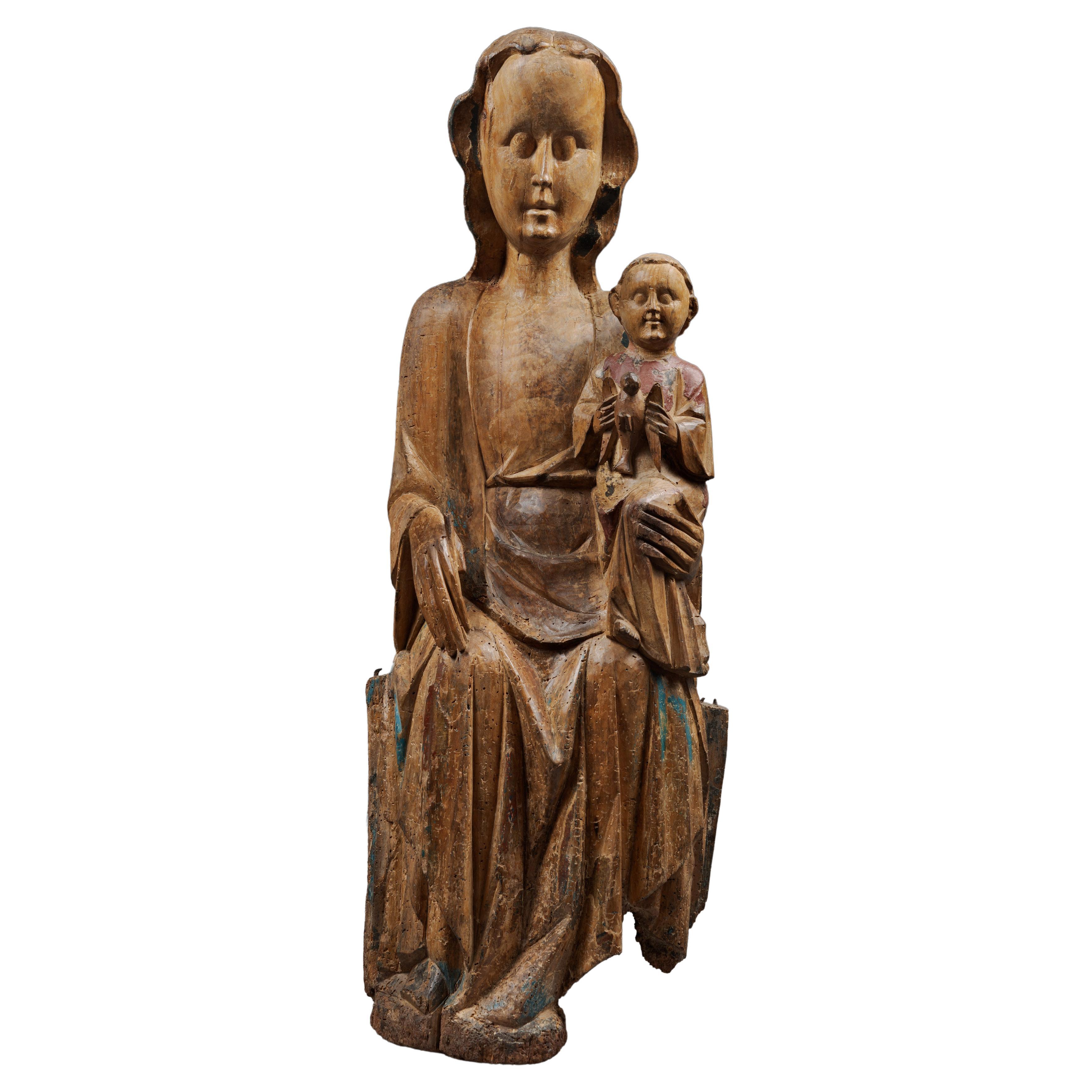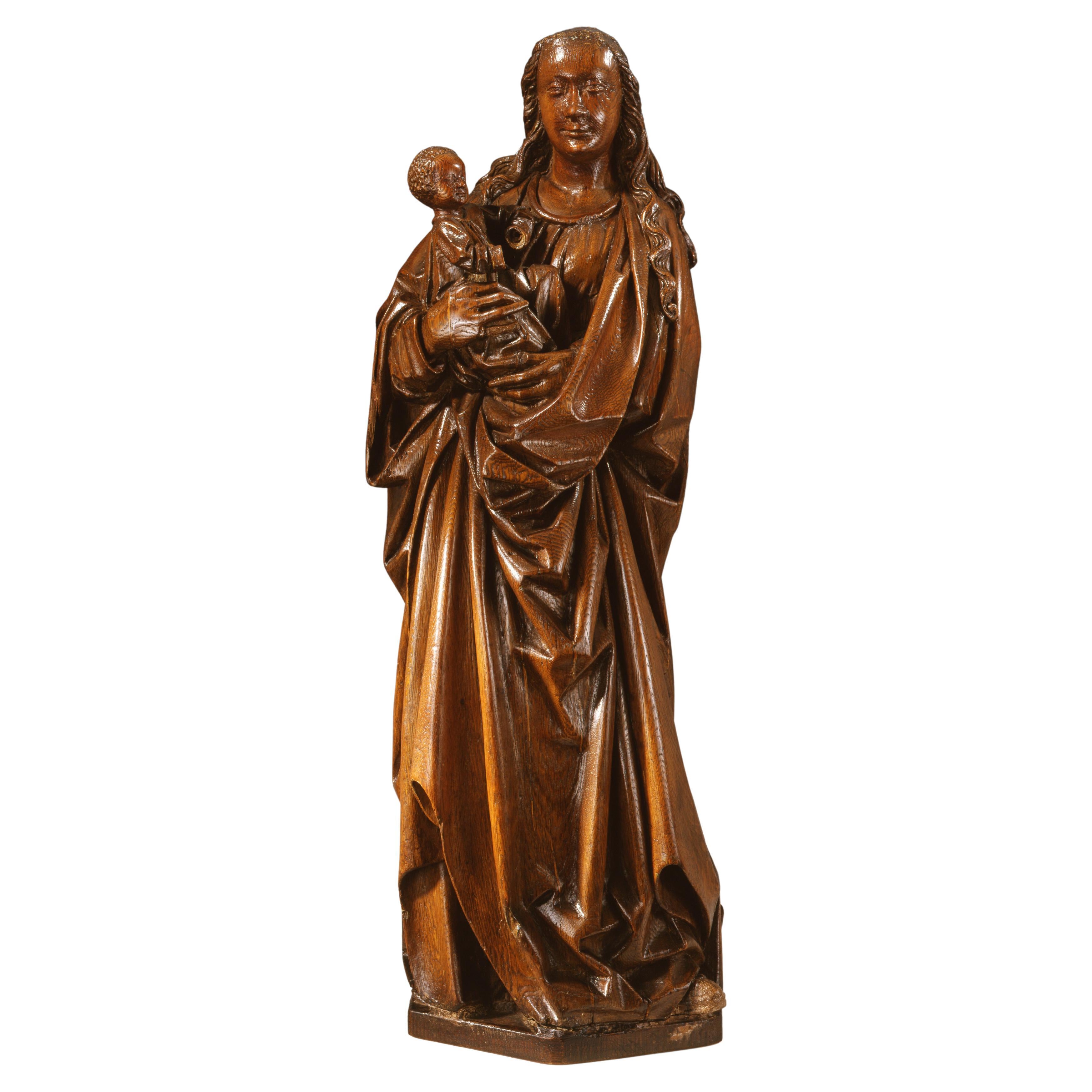Items Similar to Virgin and Child in Majesty
Want more images or videos?
Request additional images or videos from the seller
Virgin and Child in Majesty
About the Item
Virgin and child in majesty
Origine: castille
Epoque: early 14th century
Measures: Height: 72cm
Length: 30cm
Depth: 25cm
Polychrome and gilt wood
Good condition
By the middle of the 12th century the Virgin Mary appears in churches seating in majesty and acting as a throne for her child Jesus. She is then called Sedes Sapientiae meaning throne of wisdom. She is not really depicted for herself but rather because she has been designated as Theotokos, mother of God, during the council of Ephesus in 431. The same council promulgated Christ’s nature was divine since his birth.
The theme of the virgin and child in Majesty was particularly important during Medieval times. Pilgrims favoured its development while spreading its iconography.
This Virgin and Child seating on a bench throne wears supple clothes elongating her figure. The dress is belted and the collar is round worn under a coat covering her knees. The pleats of the fabric are absolutely Gothic in style. They adopt a strong V shape with deep angles on the cloak and delicate inclined pleats on the tunic.
The Virgin presents an oval face with a straight nose, a small mouth and small round chin. She wears a crown. Her curly hair spreads on her back in well defined strands.
The child does not adopt the hieratic position of 12th century sculpted groups. He slightly turns his head towards his mother’s hand. Furthermore he is presented unsteady giving a sense of movement as well as producing a deep fold, shaped as an M, in his tunic. This detail is characteristic of Castilian productions from the late 13th century and early 14th century.
Indeed the mother and child lose the hieratic aspect present in previous centuries depictions. They are animated with a new sense of movement. The faces are more realistic and the figures are less elongated than during the 13th century, the proportions are well executed. This leads us to think this work was made during the first decade of the 14th century. The smile appearing on both faces support further this datation.
This Virgin and Child is an exceptional example of 14th century Spanish art and it reached us in an equally exceptional condition.
Literature
Fons del Museu Frederic Marès/1, Catàleg d’escultura i pintura medievals, Ajuntament de Barcelona, 1991.
- Dimensions:Height: 28.35 in (72 cm)Width: 11.82 in (30 cm)Depth: 9.85 in (25 cm)
- Materials and Techniques:
- Period:
- Date of Manufacture:Early 14th Century
- Condition:
- Seller Location:Saint-Ouen, FR
- Reference Number:1stDibs: LU3115329587152

About the Seller
5.0
Vetted Seller
These experienced sellers undergo a comprehensive evaluation by our team of in-house experts.
Established in 2016
1stDibs seller since 2017
158 sales on 1stDibs
Typical response time: 8 hours
- ShippingRetrieving quote...Ships From: Saint-Ouen, France
- Return PolicyThis item cannot be returned.
More From This SellerView All
- Important Virgin and Child in MajestyLocated in Saint-Ouen, FRImportant virgin and child in majesty Origin : Germany Or Eastern France Époque : Second Half Of The 13th Century Height: 104.5 cm Length: 3...Category
Antique 15th Century and Earlier Figurative Sculptures
MaterialsOak
- Virgin and Child in Majesty with a BirdLocated in Saint-Ouen, FRVirgin and child in majesty with a bird Origin: Southern Germany Or Austria Period: Late 13tth - Early 14th Century Height : 87.5 cm Length : 32 cm Depth : 19 cm Lime ...Category
Antique 15th Century and Earlier Figurative Sculptures
MaterialsWood
- Virgin and Child in Majesty, also known as "Sedes Sapientae"Located in Saint-Ouen, FRVIRGIN AND CHILD IN MAJESTY, ALSO KNOWN AS "SEDES SAPIENTIAE" ORIGIN : SPAIN, CATALOGNE PERIOD: EARLY 13th CENTURY Height : 95 cm Width : 32 cm Depth : 28 cm Softwood No polychromy In the middle of the 12th century, the Virgin took her place in churches, seated in Majesty, serving as a throne for her son Jesus. She is then called Sedes Sapientiae, meaning the Throne of Wisdom. At that time, she is not represented for herself and only exists because she has been designated as Theotokos, the mother of God, at the Council of Ephesus in 431, where the divine nature of Christ was proclaimed from his birth. The upright and perfectly hieratic bust of this Virgin and Child in Majesty is seated on a throne-bench. She is dressed in a tunic with a rounded neckline and covered with a fine mantle placed on her narrow shoulders. The supple and natural drapery follows the lines of the body. Large curls frame her face with delicate and regular features, a long straight nose, almond-shaped eyes, and small lips. She supports the Infant Jesus with her left hand. Like his mother, he is dressed in a long tunic, and his little feet are visible in the folds. He holds a small sphere in his left hand, while with his right hand, he gestures in blessing. The face of Christ bears a strong resemblance to his mother’s one, and he gives a slight smile. The position of the Child is no longer as hieratic, nor frontal or central as in the early 12th century, but his face still turns towards the faithful. The 13th century indeed emerges as a period of transition in the artistic domain. The statuary, while retaining certain characteristics still belonging to the habits of the previous century, also develops new formal solutions. As a result, Mary maintains a hieratic and frontal position, while her son shifts to place himself well to the left on her knee. Similarly, while the Virgin seems perfectly still, Jesus, on the other hand, appears much more animated, especially in the positioning of his hands. His left hand holds the orb, and judging by the raised right arm directed towards the faithful, one can easily imagine that he was making a gesture of blessing. The influence of the Sedes Sapientiae from previous centuries still seems particularly prevalent in this work. These few characteristics allow dating this Spanish Virgin...Category
Antique 15th Century and Earlier Spanish Gothic Figurative Sculptures
MaterialsSoftwood
- Exceptional Virgin and Child in Majesty or "Sedes Sapientiae", Throne of WisdomLocated in Saint-Ouen, FRExceptional virgin and child in majesty or “Sedes Sapientiae”, throne of wisdom Origin: southwestern France. Period: late 12th - early 13th cen...Category
Antique 15th Century and Earlier Figurative Sculptures
MaterialsWalnut
- Gothic Virgin and Child with a PhylacteryLocated in Saint-Ouen, FRThis Virgin and Child is wearing clothes with a limited number of folds and showing a thickness characteristic of the Burgundy region. As a result of the presence in the region of th...Category
Antique 15th Century and Earlier French Gothic Figurative Sculptures
MaterialsWalnut
- Gothic Virgin and Child from FlandersLocated in Saint-Ouen, FRExhibition Museum Cantini, 1952, The art of the Middle Ages in the Marseille collections, n°101 Provenance Former collection Louis Bresset (before 1952) Former collection Profe...Category
Antique 15th Century and Earlier Dutch Gothic Figurative Sculptures
MaterialsOak
You May Also Like
- Antique Enthroned Virgin Mary and ChildLocated in Doha, QAThis extraordinary museum piece Enthroned Virgin Mary with the child on her lap comes from the Rhone region in France. The saint symbol and protector ...Category
Antique 15th Century and Earlier French Gothic Figurative Sculptures
MaterialsWood, Walnut
- Georges Jouve Virgin and Child, 1944By Georges JouveLocated in Saint Ouen, FRGeorges Jouve Virgin and child Black glazed ceramic with iridescent metallic luster Bears the signature on the back as well as the alpha symbol, c...Category
Vintage 1940s French Figurative Sculptures
MaterialsCeramic
- Ceramic Virgin with ChildLocated in grand Lancy, CHCeramic virgin with child.Category
Vintage 1950s European Figurative Sculptures
MaterialsCeramic
- Large Virgin and Child in polychrome wood, Spain, 16th CenturyLocated in PARIS, FRLarge painted and carved wooden Virgin and Child in the round, representing the Virgin and Child carrying the globe. The theme of the Virgin and Child is the most represented in all ...Category
Antique 1630s Spanish Renaissance Figurative Sculptures
MaterialsWood
- Large Virgin and Child, Tyrol, 16th centuryLocated in PARIS, FRLarge wooden Madonna and Child, painted and carved in hollow at the back. The theme of the Virgin and Child is the most represented in all Christian art, whereas the infancy of Jesus...Category
Antique 16th Century German Renaissance Figurative Sculptures
MaterialsWood, Pine
- Saint Joseph and Virgin with Child candlestick sculptureLocated in Benalmadena, ESFantastic large sculptures with their 68 cm high representing Saint Joseph and the Virgin Mary with the baby Jesus in her arms made of metal with great quality craftsmanship and atte...Category
Late 20th Century Figurative Sculptures
MaterialsMetal





